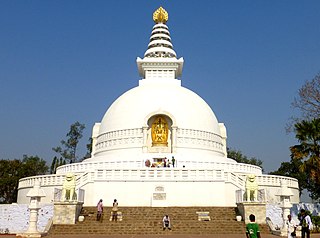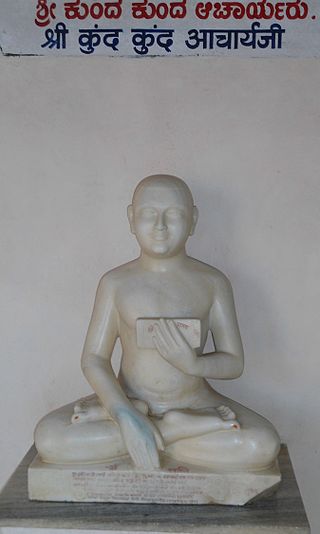Jainism, also known as Jain Dharma, is an Indian religion. Jainism traces its spiritual ideas and history through the succession of twenty-four tirthankaras, with the first in the current time cycle being Rishabhadeva, whom the tradition holds to have lived millions of years ago, the twenty-third tirthankara Parshvanatha, whom historians date to the 9th century BCE, and the twenty-fourth tirthankara Mahavira, around 600 BCE. Jainism is considered to be an eternal dharma with the tirthankaras guiding every time cycle of the cosmology. The three main pillars of Jainism are ahiṃsā (non-violence), anekāntavāda (non-absolutism), and aparigraha (asceticism).

Mahavira also known as Vardhaman, Mahavirswami, was the 24th tirthankara of Jainism. He was the spiritual successor of the 23rd tirthankara Parshvanatha. Mahavira was born in the early part of the 6th century BCE into a royal Kshatriya Jain family in ancient India. His mother's name was Trishala and his father's name was Siddhartha. They were lay devotees of Parshvanatha. Mahavira abandoned all worldly possessions at the age of about 30 and left home in pursuit of spiritual awakening, becoming an ascetic. Mahavira practiced intense meditation and severe austerities for twelve and a half years, after which he attained Kevala Jnana (omniscience). He preached for 30 years and attained Moksha (liberation) in the 6th century BCE, although the year varies by sect.

Mahavir Janma Kalyanak is one of the most important religious festivals in Jainism. It celebrates the birth of Mahavir, the twenty-fourth and last Tirthankara of present Avasarpiṇī. On the Gregorian calendar, the holiday occurs either in March or April.

The Śvētāmbara is one of the two main branches of Jainism, the other being the Digambara. Śvētāmbara means "white-clad", and refers to its ascetics' practice of wearing white clothes, which sets it apart from the Digambara "sky-clad" Jains, whose ascetic practitioners go nude. Śvētāmbaras, unlike Digambaras, do not believe that ascetics must practice nudity.

Magadha was a region and one of the sixteen Mahajanapadas, 'Great Kingdoms' of the Second Urbanization in what is now south Bihar at the eastern Ganges Plain. Magadha was ruled by Brihadratha dynasty, Pradyota dynasty, Haryanka dynasty, the Shaishunaga dynasty and the Mauryan dynasty by the end of it. Villages had their own assemblies under their local chiefs called Gramakas. Their administrations were divided into executive, judicial, and military functions.

Rajgir, meaning "The City of Kings," is a historic town in the district of Nalanda in Bihar, India. As the ancient seat and capital of the Haryanka dynasty, the Pradyota dynasty, the Brihadratha dynasty and the Mauryan Empire, as well as the dwelling ground of such historical figures as The Buddha and The Mahavira, the city holds a place of prominence in Hindu, Buddhist and Jain scriptures. As of 2011, the population of the town was reported to be 71,459 while the population in the community development block was about 88,500.

In Jainism, a Tirthankara is a saviour and spiritual teacher of the dharma. The word tirthankara signifies the founder of a tirtha, which is a fordable passage across the sea of interminable births and deaths, the saṃsāra. According to Jains, Tirthankars are the supreme preachers of Dharma, who have conquered the saṃsāra, the cycle of death and rebirth, on their own, and made a path for others to follow. After understanding the true nature of the self or soul, the Tīrthaṅkara attains Kevala Gyana (omniscience). Tirthankara provides a bridge for others to follow the new teacher from saṃsāra to moksha (liberation).

Shikharji, also known as Sammed or Sammet Shikharji, is one of the Holiest pilgrimage sites for Jains, in Giridih district, Jharkhand. It is located on Parasnath hill, the highest mountain in the state of Jharkhand. It is the most important Jain Tirtha by both Digambara and Śvētāmbara, for it is the place where twenty of the twenty-four Jain tirthankaras along with many other monks attained Moksha. It is one of the five principal pilgrimage destinations along with Girnar,Pawapuri, champapuri, Dilwara, Palitana and Ashtapad Kailash.

Parshvanatha, also Pārśvanātha, Parshva, Pārśva and Parasnath, was the 23rd of 24 Tirthankaras of Jainism. He is the only Tirthankara who gained the title of Kalīkālkalpataru.

Trishala, also known as Videhadatta, Priyakarini, or Trishala Mata, was the mother of Mahavira, the 24th Tirthankara of Jainism, and wife of the Jain monarch, Siddhartha of Kundagrama, of present-day Bihar. She finds mention in the Jain texts.

Vaishali, Vesali or Vaiśālī was a city in present-day Bihar, India, and is now an archaeological site. It is a part of the Tirhut Division.
Jainism is a religion founded in ancient India. Jains trace their history through twenty-four tirthankara and revere Rishabhanatha as the first tirthankara. Some artifacts found in the Indus Valley civilization have been suggested as a link to ancient Jain culture, but very little is known about the Indus Valley iconography and script. The last two tirthankara, the 23rd tirthankara Parshvanatha and the 24th tirthankara Mahavira are considered historical figures. Mahavira was a contemporary of the Buddha. According to Jain texts, the 22nd Tirthankara Neminatha lived about 5,000 years ago and was the cousin of Krishna.
Bihar (Hindi: Bihar,, [Bihar] in eastern India is one of the oldest inhabited places in the world with a history going back 3000 years. The rich culture and heritage of Bihar is evident from the innumerable ancient monuments that are dotted all over the state. Bihar is home to many tourist attractions and is visited by large numbers of tourists from all over the world. Around total 6 million tourists visit Bihar every year.
Hinduism is the most followed religion in Bihar, followed by nearly 82.7% of total population as per 2011 Census. Islam is the second-most followed religion which is followed by nearly 16.8% of population. There is also a significant population of Jains and Christians in the state.

Digambara is one of the two major schools of Jainism, the other being Śvētāmbara (white-clad). The Sanskrit word Digambara means "sky-clad", referring to their traditional monastic practice of neither possessing nor wearing any clothes.

Jain sculptures or Jain idols are the images depicting Tirthankaras. These images are worshiped by the followers of Jainism. The sculpture can depict any of the twenty-four tirthankaras with images depicting Parshvanatha, Rishabhanatha, or Mahāvīra being more popular. Jain sculptures are an example of Jain art. There is a long history of construction of Jain sculptures. Early examples include Lohanipur Torsos which has been regarded to be from the Maurya period, and images from the Kushan period from Mathura.

Chandraprabha or Chandranatha is the eighth Tirthankara of Tīrthaṅkara of Jainism in the present age. According to traditional accounts, he was born to King Mahasena and Queen Lakshmana Devi at Chandrapuri to the Ikshvaku dynasty. According to Jain texts, his birth-date was the twelfth day of the Posh Krishna month of the Indian calendar. He is said to have become a siddha, a liberated soul which has destroyed all of its karma.

The Jal Mandir or Water Temple is situated in Pawapuri, in the Indian state of Bihar. It is a major pilgrimage destination of Jains and the temple is dedicated to Mahavira, the 24th Tirthankara, which marks the place of his cremation. Mahavira attained Nirvana (death) in Pawapuri in 527 BC. The temple was originally built by King Nandivardhan, elder brother of Mahavira, within the pond which is filled with red coloured lotus flowers. It is one of the five main temples in Pawpuri, where the "Charan Paduka" or foot impression of Mahavira is deified.

Jainism in Bihar trace a long history since the times of twenty-fourth Tirthankara Mahavira, who was born in Vaishali. The state of Bihar is considered to have played an important role in the development of Jainism.

Jain temple, Kundalpur is a complex of six Jain temples located in Kundalpur village near Nalanda, Bihar. Kundalpur is one of the most important Jain pilgrimages in Bihar.

















